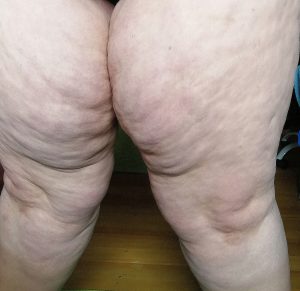It’s Lipoedema, and it’s not always a weight issue!
09 October 2020
Do you keep an active lifestyle, exercise consistently and have a sensible relationship to food? For curiosity sake, are you targeting specific areas in vain?
Lipoedema
By and large, Lipoedema is a relatively unknown disease. This condition involves an abnormal amount of fat tissue (adipose) distributed under the skin, at the waists, hips, buttocks, thighs, calves and the arms as well. Unfortunately, lipoedema is resistant to exercise and changes in diet. For that reason, the medical profession and other health practitioners alike overlook it. For the most part, it remains undiagnosed. Consequently, the lower body is uniquely massive in the later stages, when compared to the upper.
Causes
Would you have guessed its hormones that trigger Lipoedema? It happens during puberty, pregnancy and peri-menopause. Similarly, being predisposed to your genetic composition is a part of the equation as well. Eventually, lipoedema not only worsens with time but also impacts on moving freely. Hence, apart from other reasons, lymphatic disturbances occur. Furthermore, lipo-lymphedema develops subsequently.
Characteristics
I noticed some of my clients afflicted with Lipoedema bruise easily. They complain about their knees and legs feel numb, heavy, on pins and needles, throbbing, tender and painful. The majority expressed tiredness at the end of their day. As their therapist, naturally, I empathise with their feelings of insecurity and emotional distress.
Often, they are unfairly perceived as obese by the general public and advised to lose weight by medical personnel. They present with “column-like” legs attached to ankle cuffs. The saddlebags and fat lobules at their thighs and knees affect their self – image and confidence. Besides, it limits their choice of apparel. Additionally, their skin changes in colour and texture, eventually it thickens and hardens.
Management
To date, there is no known cure for Lipoedema. Someone has to be the bearer of bad news, your therapist in this case! However, liposuction slows its progression. Other conservative measures are Manual Lymphatic Drainage, Decongestive Lymphatic Therapy and Compression Therapy. Intermittent Compression Pumps (ICP) may also be included in home-care and outpatient clinics. They provide sequential compression at different settings on limbs, from distal to proximal. Some contraindications for ICP worth noting is Congestive Heart failure, Deep Vein Thrombosis (DVT) , Acute Infection ‘
As a certified Lipoedema and Lymphedema therapist, I encourage you to be pro-active in your self care. And I recommend a daily care plan that includes hygiene, skincare to protect and a low-carbohydrate diet (keto). Furthermore, regular exercise is important; it improves your mobility, lymph flow and to manage weight control.
Should you require information, education, support or just someone to talk to, please feel free to give me a call or sent me a message. I’m happy to help you and your Whanau.
You may be interested in further reading:
Risks and contraindications of medical compression treatment – A critical reappraisal. An international consensus statement
https://journals.sagepub.com/doi/full/10.1177/0268355520909066
Latest News
Operating Within The Orange Light System in 2022
10 January 2022
Hello All! I hope you had the opportunity to welcome the New Year with family and friends. Wouldn’t it be awesome to gain some normality in 2022? Despite the evolving… Read more
Lipedema, Lymphedema and High Blood Insulin
26 May 2021
The negative impact of high blood insulin on the lymphatic system, Lipedema and Lymphedema.
How does your Vagus Nerve affects bodily function?
24 May 2021
Your Vagus Nerve is also known as the Pneumogastric Nerve. It sends sensory messages to the brain and relays motor messages to our body.

